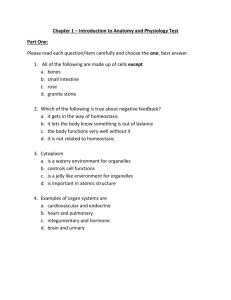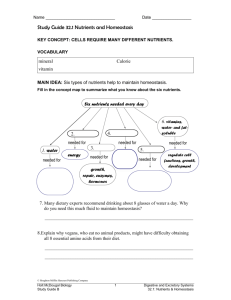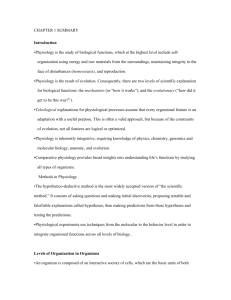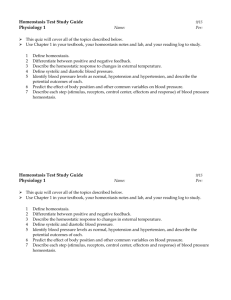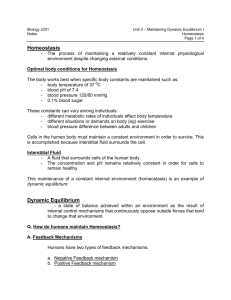Human Systems & Homeostasis Study Guide
advertisement
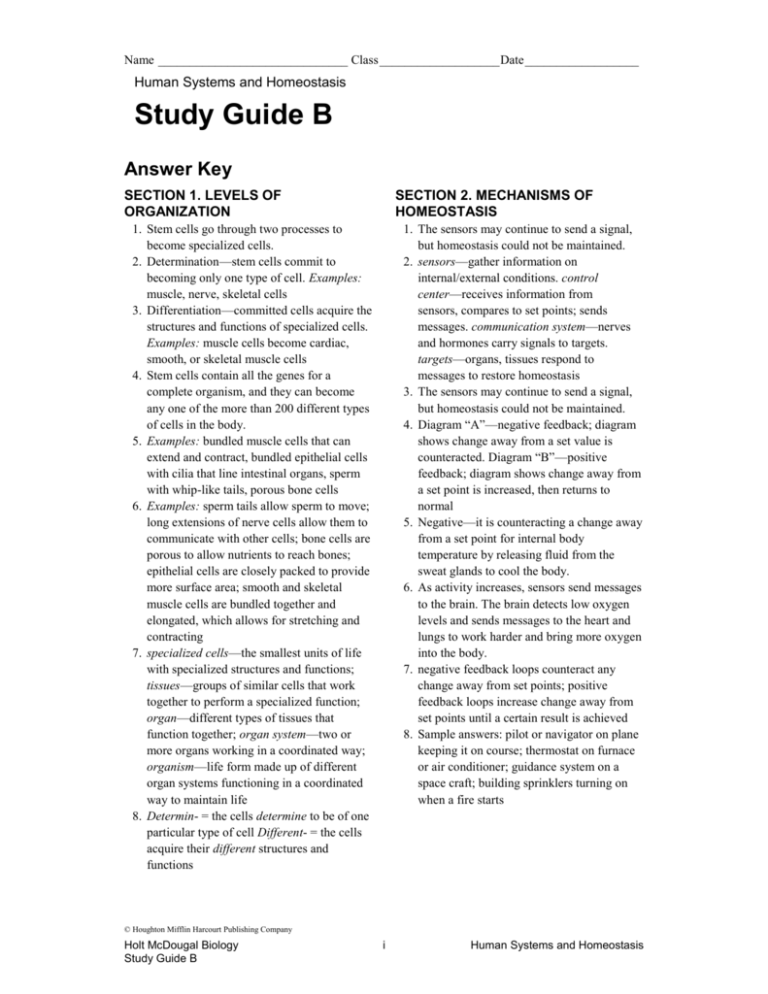
Name ______________________________ Class ___________________ Date __________________ Human Systems and Homeostasis Study Guide B Answer Key SECTION 1. LEVELS OF ORGANIZATION SECTION 2. MECHANISMS OF HOMEOSTASIS 1. Stem cells go through two processes to become specialized cells. 2. Determination—stem cells commit to becoming only one type of cell. Examples: muscle, nerve, skeletal cells 3. Differentiation—committed cells acquire the structures and functions of specialized cells. Examples: muscle cells become cardiac, smooth, or skeletal muscle cells 4. Stem cells contain all the genes for a complete organism, and they can become any one of the more than 200 different types of cells in the body. 5. Examples: bundled muscle cells that can extend and contract, bundled epithelial cells with cilia that line intestinal organs, sperm with whip-like tails, porous bone cells 6. Examples: sperm tails allow sperm to move; long extensions of nerve cells allow them to communicate with other cells; bone cells are porous to allow nutrients to reach bones; epithelial cells are closely packed to provide more surface area; smooth and skeletal muscle cells are bundled together and elongated, which allows for stretching and contracting 7. specialized cells—the smallest units of life with specialized structures and functions; tissues—groups of similar cells that work together to perform a specialized function; organ—different types of tissues that function together; organ system—two or more organs working in a coordinated way; organism—life form made up of different organ systems functioning in a coordinated way to maintain life 8. Determin- = the cells determine to be of one particular type of cell Different- = the cells acquire their different structures and functions 1. The sensors may continue to send a signal, but homeostasis could not be maintained. 2. sensors—gather information on internal/external conditions. control center—receives information from sensors, compares to set points; sends messages. communication system—nerves and hormones carry signals to targets. targets—organs, tissues respond to messages to restore homeostasis 3. The sensors may continue to send a signal, but homeostasis could not be maintained. 4. Diagram “A”—negative feedback; diagram shows change away from a set value is counteracted. Diagram “B”—positive feedback; diagram shows change away from a set point is increased, then returns to normal 5. Negative—it is counteracting a change away from a set point for internal body temperature by releasing fluid from the sweat glands to cool the body. 6. As activity increases, sensors send messages to the brain. The brain detects low oxygen levels and sends messages to the heart and lungs to work harder and bring more oxygen into the body. 7. negative feedback loops counteract any change away from set points; positive feedback loops increase change away from set points until a certain result is achieved 8. Sample answers: pilot or navigator on plane keeping it on course; thermostat on furnace or air conditioner; guidance system on a space craft; building sprinklers turning on when a fire starts © Houghton Mifflin Harcourt Publishing Company Holt McDougal Biology Study Guide B i Human Systems and Homeostasis Name ______________________________ Class ___________________ Date __________________ Study Guide B continued SECTION 3. INTERACTIONS AMONG SYSTEMS 1. Sample answers: members of a sports team, or an orchestra, or a touring rock band, or a construction crew, or a movie production working together; each individual has a job to do, but all must work together for the enterprise to succeed 2. Skin—absorbs UV light to make an inactive form of vitamin D; Liver—changes inactive form of vitamin D into another compound; Kidneys—converts compound into active vitamin D 3. Hypothalamus acts as a control center that receives data about body temperature and sends messages to target organs in the skin, respiratory, and circulatory systems. 4. Any of the following: external or internal conditions change too rapidly, serious injuries overwhelm homeostatic mechanisms, sensors fail to detect internal 5. 6. 7. 8. 9. 10. 11. or external changes, wrong messages are sent or targets fail to respond, viruses or bacteria change the body’s internal chemistry Long-term disruptions over time affect more and more organs and organ systems, resulting in greater damage to the body. short term little lasting damage common cold long term diabetes Sample answer: a thermostat or closed circuit or a balance tray that is returned to a center point. © Houghton Mifflin Harcourt Publishing Company Holt McDougal Biology Study Guide B ii Human Systems and Homeostasis Name ______________________________ Class ___________________ Date __________________ Section 1: Levels of Organization Study Guide B KEY CONCEPT The human body has five levels of organization. VOCABULARY determination organ differentiation organ system tissue MAIN IDEA: Specialized cells develop from a single zygote. Fill in the main idea and supporting information for cell development. 1. Stem cells: 2. Determination: 3. Differentiation: 4. What are the characteristics of stem cells? _______________________________________________________________ _______________________________________________________________ 5. Look at Figure 1.2. Describe some of the shapes and structures that the cells in this figure acquired during differentiation. _______________________________________________________________ _______________________________________________________________ _______________________________________________________________ © Houghton Mifflin Harcourt Publishing Company Holt McDougal Biology Study Guide B 1 Human Systems and Homeostasis Section 1: Levels of Organization Name ______________________________ Class ___________________ Date __________________ Study Guide B continued 6. Give two examples of how cell structures relate to cell functions. _______________________________________________________________ _______________________________________________________________ _______________________________________________________________ MAIN IDEA: Specialized cells function together in tissues, organs, organ systems, and the whole organism. 7. Write a description of each level of organization and draw a sketch to help you remember it. Level of Organization Description Sketch Vocabulary Check 8. There is an easy way to remember the difference between determination and differentiation. Look at the first part of each word. Explain how these word parts can help you remember the meaning of each term. _______________________________________________________________ _______________________________________________________________ © Houghton Mifflin Harcourt Publishing Company Holt McDougal Biology Study Guide B 2 Human Systems and Homeostasis Section 1: Levels of Organization Name ______________________________ Class ___________________ Date __________________ Section 2: Mechanisms of Homeostasis Study Guide B KEY CONCEPT Homeostasis is the regulation and maintenance of the internal environment. VOCABULARY homeostasis negative feedback feedback positive feedback MAIN IDEA: Conditions within the body must remain within a narrow range. 1. Give two reasons why it is so important that the internal environment of the body remains stable. _______________________________________________________________ _______________________________________________________________ _______________________________________________________________ 2. Homeostasis is maintained by control systems. Fill in the name and function of the parts of the control system in the cycle diagram below. Sensors Control center Targets Communication system 3. What might happen if a target organ cannot respond? _______________________________________________________________ _______________________________________________________________ _______________________________________________________________ © Houghton Mifflin Harcourt Publishing Company Holt McDougal Biology Study Guide B 3 Human Systems and Homeostasis Section 2: Mechanisms of Homeostasis Name ______________________________ Class ___________________ Date __________________ Study Guide B continued MAIN IDEA: Negative feedback loops are necessary for homeostasis. 4. Study the following line drawings. Which of the following diagrams represents negative feedback and which represents positive feedback? Explain your answer. A. B. _______________________________________________________________ _______________________________________________________________ 5. It’s a hot day and you’re sweating. Is this response an example of a positive or negative feedback loop? Explain your answer. _______________________________________________________________ _______________________________________________________________ 6. When you run, your muscles require more oxygen as their level of activity increases. Explain briefly how your control systems act to bring more oxygen into your body. _______________________________________________________________ _______________________________________________________________ _______________________________________________________________ Vocabulary Check 7. What is the difference between positive and negative feedback loops? _______________________________________________________________ _______________________________________________________________ 8. Think of an analogy that would illustrate the process of feedback for someone who does not know what the word means. _______________________________________________________________ © Houghton Mifflin Harcourt Publishing Company Holt McDougal Biology Study Guide B 4 Human Systems and Homeostasis Section 2: Mechanisms of Homeostasis Name ______________________________ Class ___________________ Date __________________ Section 3: Interactions Among Systems Study Guide B KEY CONCEPT Systems interact to maintain homeostasis. VOCABULARY thermoregulation MAIN IDEA: Each organ affects other organ systems. 1. The organs in the body work together like members of a pit crew servicing a race car. What other analogies can you think of to illustrate organ systems working together? _______________________________________________________________ _______________________________________________________________ _______________________________________________________________ 2. Fill in the table below to explain what each organ does to help produce vitamin D in your body. Organ Function Skin Liver Kidneys 3. What role does the hypothalamus play to help regulate body temperature? _______________________________________________________________ _______________________________________________________________ _______________________________________________________________ MAIN IDEA: A disruption of homeostasis can be harmful. 4. List three reasons why homeostasis in the body might be disrupted. _______________________________________________________________ _______________________________________________________________ © Houghton Mifflin Harcourt Publishing Company Holt McDougal Biology Study Guide B 5 Human Systems and Homeostasis Section 3: Interactions Among Systems Name ______________________________ Class ___________________ Date __________________ Study Guide B continued 5. Why is a long-term disruption of homeostasis usually more serious than a short-term disruption? _______________________________________________________________ _______________________________________________________________ Fill in the concept map to help you remember what you know about long-term and short-term disruption of homeostasis. Disruption of homeostasis can be 6. 9. usually leads to can lead to 10. damage to many organs over time 7. example example 8. 11. Vocabulary Check 11. Think of a diagram that might illustrate the term thermoregulation for someone unfamiliar with the word. Use the space below to sketch your diagram. © Houghton Mifflin Harcourt Publishing Company Holt McDougal Biology Study Guide B 6 Human Systems and Homeostasis Section 3: Interactions Among Systems
